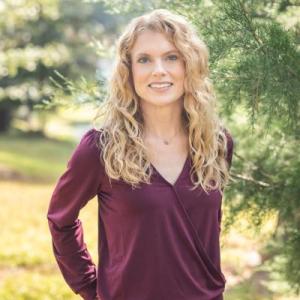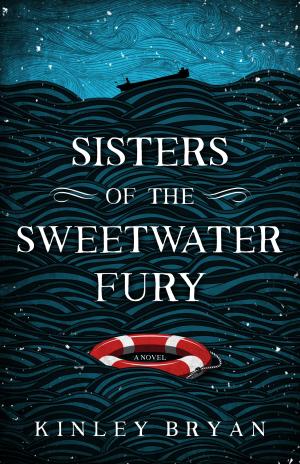
It is said that you should write what you know.
In Kinley Bryan's case, she turned family stories into a novel titled Sisters of the Sweetwater Fury, which was honored with a 2022 Selfie Award by Publishers Weekly.
Growing up in Northampton Township, which is now part of Cuyahoga Falls, the Woodridge High School and Kent State graduate heard tales of her ancestors who were sailors on the Great Lakes. While working in corporate communications, Bryan later lived in an old cottage on Lake Erie, which further fostered her love for inland seas.
Now living on the Atlantic Coast, Bryan has spun that family history into a work of historical fiction that centers around three sisters – all of which have a connection to the Great Lakes when the deadly storm of 1913 hit the region.
Bryan will discuss her work when she kicks off the 2023 Fogle Author Series at Rodman Public Library on Tuesday, July 18 at 6:30 p.m.
Registration is required to attend the program at which books will be available for sale and Bryan will sign them after delivering her remarks.
Other authors to be featured during the 2023 Fogle Author Series are James De Monte on Monday, August 28, and James Renner on Monday, September 11.
In advance of her visit, here are some questions and answers with Kinley Bryan:
 Q: Your book is based off of stories in your family. How did you first hear of them?
Q: Your book is based off of stories in your family. How did you first hear of them?
A: Quite a few of my ancestors were sailors on the Great Lakes, including my great-grandparents, Walter and Annabel Stalker. The setting for Sisters of the Sweetwater Fury was inspired by stories my father told me about the Great Lakes Storm of 1913, the most devastating storm in the region’s history. It lasted several days, with hurricane-force winds, 35-foot waves, and whiteout blizzard conditions. At least 250 sailors perished; the storm sank a dozen steel freighters, stranding many more. My great-grandparents were caught in this horrific storm.
In November 1913, Walter Stalker was the captain of the Golden Age, a four-masted schooner that had been the largest sailing vessel in the world when built in 1882. Annabel was the ship’s cook. At least one of their children was also aboard. During the horrific storm they found shelter in a cove on Lake Michigan’s Beaver Island. As they waited out the gale, Annabel told Walter she was through with sailing, and that if they survived she wanted to go ashore for good. And that’s exactly what they did. I should add that, while this family history was the inspiration for the novel’s setting, the characters in Sisters of the Sweetwater Fury are purely fictional.
Q: How did you get interested in historical fiction and what made you decide to take up writing?
A: I’ve always loved reading historical fiction. Historical settings make for a good escape from everyday life, and if I can learn something about a different time or event, that’s all the better. I started writing fiction about eleven years ago, when my children were very young. I had just left a corporate communications career following a move from Ohio to Georgia. Writing a novel had long been a dream of mine. Even so, publishing a novel seemed like an overly grand aspiration at the time, and so I wrote in secret, drafting a novel loosely based on my life.
It took me years to learn the craft of writing fiction, and to get to the point where I felt my writing was ready for the world. Although Sisters of the Sweetwater Fury is the first book I published, it’s the fourth one I wrote. I now consider those first three as practice.
Q: Did you always want to be a writer? What did you do before you became a writer?
A: Though it was a long time before I seriously considered writing a novel, writing has always been part of my life in some way. As a child, I filled notebooks with poetry styled after Shel Silverstein and wrote plays that I persuaded my brothers to perform with me. At Kent State, I majored in English, interned at the university press, and worked part-time as a writing tutor. After graduation I looked for a job that involved writing. I remember interviewing for a public relations position and the interviewer asked, somewhat incredulously, if I would be okay if most of my workday was spent writing. I remember thinking, “Would I? Yes, please!” I ended up working in corporate communications for a decade before turning to novel writing.
Q: Who are your favorite writers? Do you have any favorite books?
A: I’m a big fan of Emily St. John Mandel and Amor Towles for their lyrical prose, and Anthony Doerr’s Cloud Cuckoo Land for its deft weaving of plot threads and the way he illustrates how characters are feeling without coming right out and telling you. I admire how Geraldine Brooks creates her characters’ voices and includes historical detail unobtrusively. A favorite historical novel of mine is Dolan Perkins Valdez’s Wench, which takes place at a summer resort that existed near Xenia, Ohio in the 1850s, notorious for its popularity among slaveholders and their enslaved mistresses. Other favorites include Karen Odden’s historical mysteries and the atmospheric Mrs. England by Stacey Halls. Lona Manning’s A Contrary Wind: A Variation on Mansfield Park is brilliant for its characterization and its emulation of Jane Austen’s style. For classics I love Edith Wharton, Jane Austen, and Kate Chopin; reading Chopin’s The Awakening in college had a profound influence on me.
Q: Your first published book won a Selfie. Were you surprised at all and is there any advice you would give to others who aspire to be successful writers?
I was very surprised! The finalists and representatives from Publishers Weekly were gathered on a Zoom call to announce the winner of each of three categories (adult fiction, children’s, and memoir). When an image of Sisters of the Sweetwater Fury appeared on my screen as the winner, my mouth dropped open. It was a thrill to have my debut novel recognized by the publishing industry. And the prize money helped me to produce an audiobook.
As for advice, because all writers go about their work differently, I would start by saying not to worry if someone else’s “must do’s” don’t work for you. What’s been important for me is a focus on craft. I’ve gleaned a lot from listening to authors talk about their work and process on the podcast, “Writers on Writing.” My favorite books on craft include The Emotional Craft of Fiction by Donald Maas, Manuscript Makeover by Elizabeth Lyon, Steering the Craft by Ursula K. LeGuin, and The Secrets of Story by Matt Bird. And anyone looking to self-publish should check out “The Self-Publishing Advice Podcast” by the Alliance of Independent Authors.
Q: What can people who come to your appearance at RPL expect to hear in your talk.
A: I’ll talk about the Great Lakes Storm of 1913 and my seafaring ancestors, as well as how the novel’s main characters came to be and why these three sisters are the heart of the story. I’ll also share a bit about my research and writing processes. And I’ll be happy to answer questions people may have.
